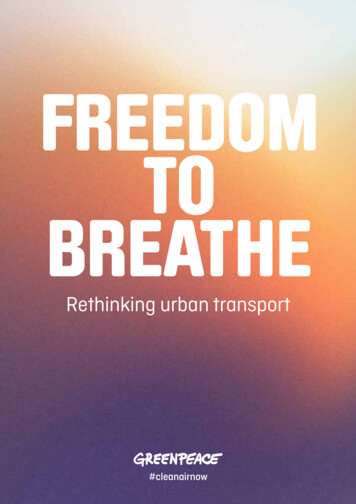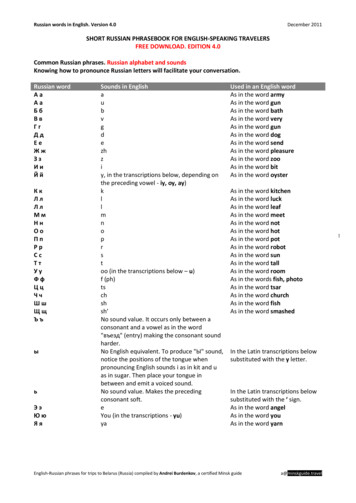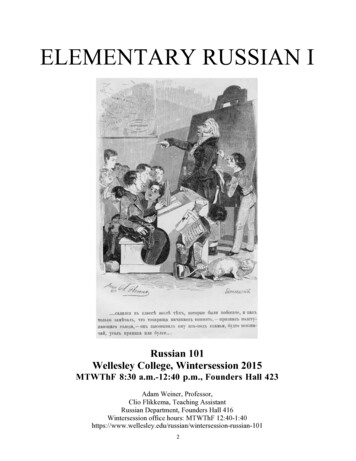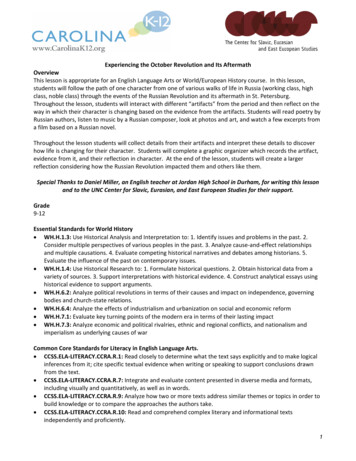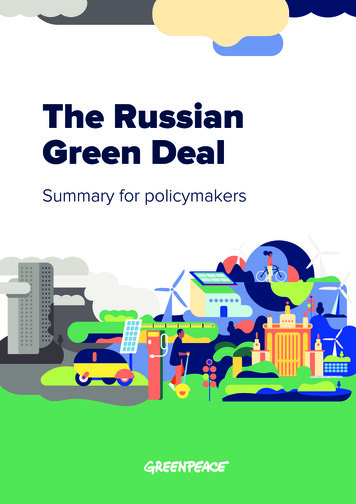
Transcription
The RussianGreen DealSummary for policymakers
After the outbreak of the COVID-19 pandemic,many non-governmental organizations,corporations, and even ministerialrepresentatives of the world’s leadingcountries expressed their vision of recovery.The vast majority of these statements callfor stimulating economies through thedevelopment of green sectors. The EUremained committed to the European GreenDeal announced before the start of thepandemic, in addition also deciding to supportgreen sectors as part of its anti-crisis policy.After the global financial crisis of 2008 – 2009,the green sectors of G20 economies receivedaltogether about 16 percent of all recoveryspending, an experience which can beregarded as an approbation of the New GreenDeal concept. Russia did not use the chanceto diversify its economy then. At the moment,when the economic situation is much lessfavorable, and the global demand for fossilfuels is weak, Russia risks missing anotheropportunity to move away from its resourcedependence.Since Russian official recovery packages omitany stimuli for the green sector, Greenpeacehas initiated public discussion of a greenrecovery by proposing the Russian GreenDeal. The document was developed withthe participation of representatives of theacademic sector, the business community, andnonprofit organizations.The Russian Green Deal is an economicframework program that will help overcomethe COVID-19 crisis and transform Russia intoa sustainable, green, and modern economy.The program sets an ambitious national goalfor Russia to achieve net zero greenhousegas (GHG) emissions or to become climateneutral by 2050. This goal is in line withthe IPCC recommendations and with GreenDeal programs and proposals across othercountries. The Russian Green Deal also sets anintermediate target to reduce GHG emissionsby 60 percent from the 1990 level by 2030.The intermediate target is recommended tobe submitted to the UNFCCC as Russia’s newNationally Determined Contribution (NDC)under the Paris Agreement.Share of GHG emission compared to 1990 level, including LULUCF100 %Real valuesOfficial planRussian Green Deal goats*LULUCF — Land-Use, Land-Use Change andForestry67 %64 %52,4 %40 %0%1990201820302050* This target is in line with Green Deal programs of other countries and with the IPCG recommendations to keep the globalaverage temperature rise within 1.5 C compared to the pre-industrial period.THE RUSSIAN GREEN DEAL3
Climate neutrality can be achieved throughaction in 3 areas: (1) clean energy, (2) acircular economy, and (3) forestry. Theenergy sector generates 79 percent of allGHG emissions in Russia, whilst the restis divided between industrial processes(11 percent), agriculture (6 percent), and wastemanagement (4 percent). The energy sectormust dramatically reduce its emissions throughachieving 100 percent renewable energy by2050 in electric power, heating / cooling, andtransportation, and through reducing RussianGDP energy intensity to the global averagelevel (in 2018, Russian GDP was 46 percentmore energy intensive than globally). InRussia, the bulk of emissions from industrialprocesses come from iron and steel, cement,and ammonia manufacturing. Together withagriculture, these sectors comprise 60 percentof GHG emissions (excluding emissionsfrom fossil fuels). Industrial and agriculturalemissions can be reduced through carbonneutral metal production (using electric arcfurnaces to melt steel, recycling metals,etc.), through using alternatives to clinker incement-making, stimulating organic farming,etc. Sustainable forestry is supposed to offsetunavoidable GHG emissions.Clean energy By 2030, the share of renewable energysources (RES) in electric power generationmust be increased to 20 percent (excludinglarge hydro1), and up to 10 percent intransport and heating / cooling. Thisincludes the electrification of transport andheating / cooling using RES and excludestraditional biomass. In 2019 in Russia, theshare of RES in electric power generationwas 0.28 percent (excluding largehydropower plants). Statistics on the shareof RES in transport and heating / coolingsectors are unavailable. By 2050, the share of RES in all energysectors must comprise 100 percent. By 2030, the energy intensity of RussianGDP must decrease by 40 percentcompared to the 2007 level. By 2050, the energy intensity of RussianGDP must decrease to the global averagelevel.1. Hydropower plants with installed capacity over 25 MW.GHG emissions in Russia in 2018, milliontons of CO₂-equivalent and %Agriculture, 6%126,7Energy, 79%1752,6Waste, 4%97,7Industrial processes, 11%243,1The Russian Green Deal program sets out the following12 targets in these three sectors, with 100 measures toachieve them.4THE RUSSIAN GREEN DEAL
Circular economyForestry By 2050, carbon neutrality must be achievedin metal and cement industries. The exploitation of the remaining wildforests must be replaced by intensiveforestry on previously developed lands. By 2050, carbon neutrality must be ensuredin agriculture. By 2050, per capita GHG emissions fromfood consumption must be reduced tothe level compatible with the 1.5 C climatetarget, including a 50 % reduction of animalproducts manufacturing and consumption. By 2030, at least 40 percent of thepopulation must have transitioned tosustainable diets (containing more plant thananimal products), whilst 75 percent of thepopulation must do so by 2050. By 2030, the per capita volume of solidmunicipal waste generation must decreaseby 30 percent compared to the 2020 level,and by 2050, by 60 percent. Full protection of forests and effectiveextinguishing of forest fires must beensured.The Russian Green Deal is focused onclimate and environmental action, yet at thesame time it represents a program that willhave a significant positive impact on theRussian economy and the public sphere.Its implementation will diversify the Russianeconomy, eliminate its dependence on fossilfuels, and create new modern industries andnew jobs. By 2050, at least 80 percent of the solidmunicipal waste must be recycled.THE RUSSIAN GREEN DEAL5
Генеральные партнёрыКоалиция за Зелёный курсКлиматический кризисреален, рукотворен, решаем.
representatives of the world's leading countries expressed their vision of recovery. The vast majority of these statements call for stimulating economies through the development of green sectors. The EU remained committed to the European Green Deal announced before the start of the pandemic, in addition also deciding to support


